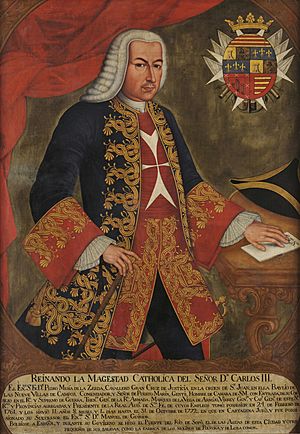Pedro Messía de la Cerda, 5th Marquis of Vega de Armijo facts for kids
Pedro Messía de la Cerda (born February 16, 1700, died April 15, 1783) was an important Spanish naval officer. He also served as a colonial official. From 1761 to 1773, he was the Viceroy of New Granada. A viceroy was like a governor chosen by the king to rule a large area. New Granada included parts of today's Colombia, Venezuela, Panama, and Ecuador.
Contents
Pedro Messía de la Cerda was born in Córdoba, Spain. He joined the navy and quickly became a skilled sailor. He took part in several battles and helped Spain conquer Sardinia and Sicily. In 1719, he fought against the British in the Battle of Cape St. Vincent.
His first trip to the Americas was in 1720. He helped stop illegal trade, called smuggling, in places like Cartagena and Portobelo. By 1745, he had become a captain.
The Famous Voyage of the Glorioso
In 1747, Pedro Messía was the captain of a Spanish warship called the Glorioso. This ship had a very important mission. It was carrying four million silver dollars from the Americas back to Spain. During its journey, the Glorioso had to fight off several British attacks. These battles happened during a conflict known as the War of Jenkins' Ear.
The Glorioso was a 70-gun ship. It managed to fight off two British attacks near the Azores and Cape Finisterre. It successfully delivered its valuable cargo to Corcubión, Spain.
After unloading the silver, the Glorioso sailed towards Cadiz for repairs. Near Cape St. Vincent, it was attacked again. This time, it faced four British privateer ships and two larger warships. One British ship, the Dartmouth, exploded during the fight. However, the 92-gun Russell eventually forced the Glorioso to surrender.
Pedro Messía de la Cerda and his crew were taken as prisoners of war. But they were seen as heroes in Spain. Even the British admired their bravery. Some British officers were punished for not performing well against the Glorioso.
In 1753, Pedro Messía was in Cartagena de Indias. He was in charge of stopping privateers, who were like legal pirates, and smugglers. He later became a lieutenant general in the navy. In 1757, he joined the Supreme Council of War, a very important military group.
Serving as Viceroy of New Granada
In March 1760, Pedro Messía was chosen to be the Viceroy of New Granada. He arrived in Cartagena in October to start his new job. A famous doctor and plant expert, José Celestino Mutis, traveled with him. Mutis later led a royal expedition to study the plants and animals of the colony.
Messía traveled to Bogotá in February 1761. He was welcomed with special ceremonies. He returned to Cartagena in 1762 when he heard that the British were attacking Havana. He came back to the capital in 1763.
Key Changes and Challenges
As viceroy, Pedro Messía made many changes. He followed orders from the Spanish King to put a tax on tobacco. He also worked to increase the amount of minerals produced in the colony. A gunpowder factory was built in Bogotá, and a saltpeter factory was built in Tunja. Saltpeter is an important ingredient for gunpowder.
He improved how the government managed money. He also made the forts in Cartagena stronger. He supported public projects, like building a road from Bogotá to Caracas. He also encouraged higher education and created a postal service run by the government.
He increased the tax on a local drink called aguardiente. This led to a rebellion in Quito in May 1765.
Dealing with Indigenous Groups
Messía helped the governor of Darién fight against attacks from the Cuna Indigenous people. He also led campaigns against the Chimila and Guajiro (Wayuu) Indigenous groups. These groups had not yet been fully controlled by the Spanish. These campaigns were not very successful.
He also faced an attack by Indigenous people on the town of Coyaima. The rebels killed some people and burned buildings. He restored order in Neiva in 1767 after another rebellion there.
Messía also tried to promote religious missions, but these did not have major results either. He started building the cathedral of Santa Marta. The first stone was laid on December 8, 1766.
Expulsion of the Jesuits
One of his most important tasks was carrying out an order from King Charles III. The king ordered the expulsion of the Jesuits from all Spanish lands. The Jesuits were a powerful religious group.
Messía de la Cerda was a friend of the Jesuits. He tried to make the expulsion less harsh. However, the order was carried out on July 31, 1767. At that time, there were many Jesuit priests, students, and brothers in New Granada. Their property was taken by the government. Many of the expelled Jesuits moved to Urbino, Italy. There, they wrote about the Americas, sharing new information with European scholars.
Returning to Spain
In 1771, Pedro Messía asked the king if he could return to Spain. The king agreed, and Messía waited for his replacement, Manuel de Guirior, to arrive. On September 14, 1772, he left for Cartagena. The next month, he officially handed over his role as viceroy to Guirior.
Pedro Messía de la Cerda lived for ten more years in Spain. He passed away in 1783.
See also
 In Spanish: Pedro Mesía de la Cerda para niños
In Spanish: Pedro Mesía de la Cerda para niños
- Guajira rebellion, a conflict Messia wrote about.


